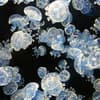Intro to Ecology: The Biosphere PDF
Document Details

Uploaded by RapturousGyrolite5789
Tags
Summary
This document provides an introduction to ecology, focusing on the biosphere and factors impacting ecosystems. Topics include biotic and abiotic factors, climate, and the interactions within different ecosystems.
Full Transcript
Intro to Ecology: The Biosphere examples Uh...
Intro to Ecology: The Biosphere examples Uh - Mn-main points Introduction Ecology = study of interactions between organisms and their environments Interspecific: between different species ex. predation Intraspecific: within a species competition ex · mate selection Studied at multiple levels: Organismal: individual physiological, evolutionary, & behavioral adaptations Population: shifts in size of groupings of the same species in the same area Community: interactions among all organisms in the same area chemical Ecosystem: energy and material flow through living (biotic) and nonliving (abiotic) components of an area biotic abiotic + Biosphere: connections between all regions at a planetary level Factors Impacting Ecology -interactions btwn potic/abiotic Biotic factors: living parts of ecosystems Microbes, plants, animals, fungi Abiotic factors: nonliving parts of ecosystems ex. mining environ. detrimental Climate: long-term weather trends Y Temperature (hot/cold; varied/stable) determined Precipitation (wet/dry; seasonal/stable) habitability Other (light/dark periods seasonal/stable, wind) of environ. Minerals/inorganic substances (heavy metals, atmospheric composition, biogeochemical cycles) Why does climate vary? weather patterns - long term (accumulation of weather reports ovaries due to location Death Same of sunlight Causes of Climate cause 1) main solar energy+ sunlight Solar energy = amount of energy received by earth’s surface Varies due to angle/latitude and elevation SE hits diff. areas of Earth unevenly - equator : more intense amt of atmosphere scatters solar energy More atmosphere = less energy Note: All areas on earth get the same annual light exposure, but not the same amount of solar energy At equator, 12hr light/12hr dark year round Toward poles, extreme shifts (20+hr dark in winter, 20+hr light in summer) Solar Energy Con’t higher elevation Solar energy impacts air - temperature decreases in temp less air pressure Less sunlight = lower average temperatures BUT altitude can compensate Increases in elevation = decreases in average temperature air Air pressure is also lower at higher lose - pick up elevations (why ears pop when flying moisture & moisture or driving over mountains); lower to air · warm condition pressure = expansion of cooler air = very dry reduced capacity to hold water Causes rain shadow effect dep on air pressure I E altitudes ↓ affected by topography Solar Energy Con’t Changes to air temperature ALSO impact air circulation patterns : at o wet air rises -not to cool air rushes in replace it dry heat 30 : cool air falls agains wet - sucks moisture Solar Energy Con’t And water currents Decrease in wind - min. air circulation H20 movement over more evaporation warm ocean (more H20) · depusits Ho to land warm wet , winters warming S · cold tot nutrients dropped Jea to floor creates upwellings -very productive Biomes Major life zones defined by vegetation (in terrestrial systems) Vegetation cannot move, thus good indicator of general climate While biomes may seem distinct, shifts are often gradual with overlap, and microclimates allow for variation within each biome Localized patterns in climatic conditions, ex: shade vs sun; north- vs south- facing slopes Major Terrestrial Biomes to burn acacias adapted ex. tropical grasslands ex. Africa warm (littleshifts) roundere3 perfectoran desert a rain forest little rain transitional zone btwn (mountains) ( morefires) affected bytopography · short plants (growing & dead sens herds large migratory - lack of precipitation (try) · scrubby of temperatures larger range climate - · mediterran temperatures round · stable year Hot deserts · cold at night/winter · dry , but more moisture than desert 300 · next to ocean ; above/between lines massive temperature fluctuations · more rains (rainy/any season temperature rains · narrow % to 60 lat shadow effect some rains leaves close rain , drop warm/wet summers 600 & short summer oneedle leaves winter overy cold no trees short aut. Of live , in · dark conditions plants $ any a time (annual plants) Soil doesn't thaw (permatrest 900 air descending > - very dry old dark > winters no plants long Aquatic Biomes Non-terrestrial systems are defined by physical characteristics (freshwater/marine, depth/light availability, movement, temperature) via" zones" Most aquatic environments are oceans (~75% of earth’s surface), but freshwater systems (rivers, lakes) are incredibly important to terrestrial biomes Interactions Environment constrains life Distribution of a particular species will be limited by both biotic and abiotic factors must be suited to environments * Plants and animals have specific ranges with appropriate conditions that they cannot dispersal beyond Limited by physical, climatic, or biological barriers But…maybe adapt?